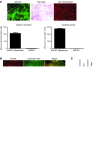Modeling inherited metabolic disorders of the liver using human induced pluripotent stem cells
- PMID: 20739751
- PMCID: PMC2929734
- DOI: 10.1172/JCI43122
Modeling inherited metabolic disorders of the liver using human induced pluripotent stem cells
Abstract
Human induced pluripotent stem (iPS) cells hold great promise for advancements in developmental biology, cell-based therapy, and modeling of human disease. Here, we examined the use of human iPS cells for modeling inherited metabolic disorders of the liver. Dermal fibroblasts from patients with various inherited metabolic diseases of the liver were used to generate a library of patient-specific human iPS cell lines. Each line was differentiated into hepatocytes using what we believe to be a novel 3-step differentiation protocol in chemically defined conditions. The resulting cells exhibited properties of mature hepatocytes, such as albumin secretion and cytochrome P450 metabolism. Moreover, cells generated from patients with 3 of the inherited metabolic conditions studied in further detail (alpha1-antitrypsin deficiency, familial hypercholesterolemia, and glycogen storage disease type 1a) were found to recapitulate key pathological features of the diseases affecting the patients from which they were derived, such as aggregation of misfolded alpha1-antitrypsin in the endoplasmic reticulum, deficient LDL receptor-mediated cholesterol uptake, and elevated lipid and glycogen accumulation. Therefore, we report a simple and effective platform for hepatocyte generation from patient-specific human iPS cells. These patient-derived hepatocytes demonstrate that it is possible to model diseases whose phenotypes are caused by pathological dysregulation of key processes within adult cells.
Figures




Comment in
-
From skin cells to hepatocytes: advances in application of iPS cell technology.J Clin Invest. 2010 Sep;120(9):3102-5. doi: 10.1172/JCI44422. Epub 2010 Aug 25. J Clin Invest. 2010. PMID: 20739747 Free PMC article. Review.
-
Modeling and therapy of human liver diseases using induced pluripotent stem cells: how far have we come?Hepatology. 2011 Feb;53(2):708-11. doi: 10.1002/hep.24143. Hepatology. 2011. PMID: 21274892 Free PMC article.
References
Publication types
MeSH terms
Substances
Grants and funding
LinkOut - more resources
Full Text Sources
Other Literature Sources
Medical
Research Materials

